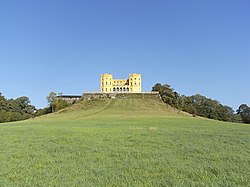Stoke Gifford
| Stoke Gifford | |
| Gloucestershire | |
|---|---|
 The Fox Den pub | |
| Location | |
| Grid reference: | ST621799 |
| Location: | 51°31’1"N, 2°32’53"W |
| Data | |
| Population: | 15,494 (2011) |
| Post town: | Bristol |
| Postcode: | BS34 |
| Dialling code: | 01454, 0117 |
| Local Government | |
| Council: | South Gloucestershire |
| Parliamentary constituency: |
Filton and Bradley Stoke |

Stoke Gifford is a large dormitory village and parish in Gloucestershire, forming part of the northern suburbs of Bristol. It had 15,494 residents at the 2011 census. It is home to Bristol Parkway railway station, on the London-Swansea railway line, and offices of Aviva insurance, Hewlett Packard and the University of the West of England.[2] The parish includes neighbouring Little Stoke, Harry Stoke and Stoke Park. The parish borders Filton, to the south-west, Patchway to the north west, Bradley Stoke to the north and Winterbourne and Hambrook to the east.[2] To the south Stoke Gifford is served by the Bristol Ring Road, south of this a large green area known as the 'Green Lung' stretches to the inner city area of St Werburgh's.
Descent of the manor
Giffard
Following the Norman Invasion of 1066, William the Conqueror gave the manor to Osbern Giffard, one of his generals. Giffard himself was a native of Longueville-le-Giffard, Normandy, now known as Longueville-sur-Scie, which is from where the 'Gifford' suffix of the name derives. The 'Stoke' suffix may come from the Stoke Brook, 'Stoke' may also be a reference to the Saxon word 'Stoche' meaning 'property of or dependent farmstead'. Bradley Stoke and Stoke Lodge, both 20th-century estates were also given the name. Extensive histories of Stoke Gifford can be found on Adrian Kerton's web pages[3] and the website of Southern Brooks Archaeology.[4]
Berkeley

The manor remained in the Giffard family until 1337, when it was granted to Maurice de Berkeley (died 1347), 2nd son of Maurice de Berkeley, 2nd Baron Berkeley (1271–1326). Thus was founded the long and distinguished cadet branch of "Berkeley of Stoke Gifford". In 1553 a new late-Tudor manor house was built by Sir Richard Berkeley (died 1604), 7th in descent from Maurice de Berkeley (died 1347). It became known as Stoke Park, and was rebuilt in 1750 by Norborne Berkeley, 4th Baron Botetourt (died 1770), from a neo-classical design by Thomas Wright.
Local amenities
The church runs a pre-school nursery in the old vicarage, and a small coffee shop in the Old School Rooms across The Green from the church, which backs onto Parkway railway station. Also in the local area are two parks, each with children's play equipment; a pair of tennis courts and a pub, the Beaufort Arms. There is a row of shops on Ratcliffe Drive including an express supermarket, dentist and medical centre and few more shops on one of the roads off North Road. There is a large supermarket within walking distance and most of the local children walk or cycle to nearby St Michael's C of E Primary School & Abbeywood Community School.
Expansion in the 20th century
Like much of the nearby area, Stoke Gifford underwent rapid expansion in the 20th century. Prior to the 1980s Stoke Gifford was just a small village, straggling along the main street, North Road.
The Old School Rooms hosts groups for the local Scouts and Brownies.
Notable people
- Colin Needham, founder of the Internet Movide Database
- Alan Medcroft, actor and 2011 Voice of UK for TomTom Satellite Navigation devices[5]
References
- ↑ by John WALKER, engraver and printseller, 16, Rosomon Street, Clerkenwell 1795–1802. Exhibited Royal Academy 1796–1800. Landscape engraver and draughtsman. He finished many of his father's plates. Published as"The Copper Plate Magazine, or Monthly Cabinet of Picturesque Prints" many drawn earlier but published 1792..1803 Engraved surface 13 x 17 cm . . .2nd state by Published 1 July 1795 by J. Walker, Rosomans Street, London
- ↑ Jump up to: 2.0 2.1 "Home". Stokegifford.org.uk. http://www.stokegifford.org.uk/. Retrieved 10 March 2012.
- ↑ Adrian Kerton. "Abtract Art by Adrian Kerton, paintings by Isabelle Pommier". Akk.me.uk. http://www.akk.me.uk. Retrieved 10 March 2012.
- ↑ Adrian Kerton (25 March 2009). "Southern Brooks Archaeology". Sbarch.org.uk. http://www.sbarch.org.uk/. Retrieved 10 March 2012.
- ↑ "BBC – TomTom picks South Gloucestershire voice for sat-nav". BBC News. 15 December 2010. http://news.bbc.co.uk/local/bristol/hi/people_and_places/newsid_9285000/9285401.stm. Retrieved 10 March 2012.
Outside links
| ("Wikimedia Commons" has material about Stoke Gifford) |